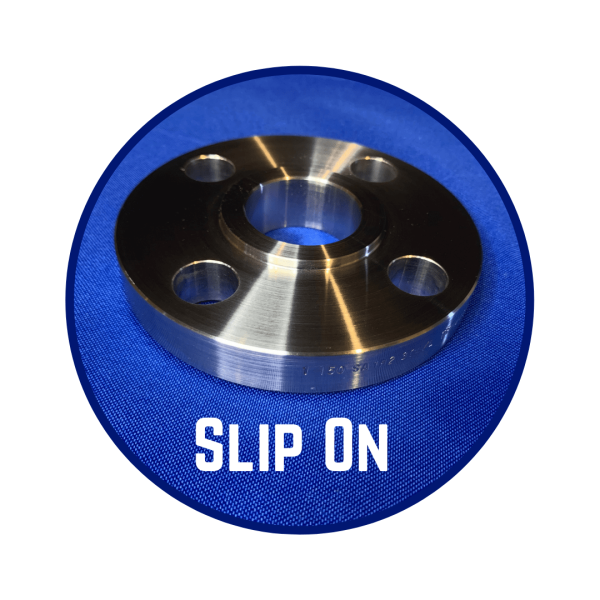Slip On Flanges are flanges slipped over the end of pipes and then welded in place. Flanges are widespread in low-pressure applications owing to their ease of installation. Slip-on flanges (SOF) are crucial in piping installations and pipeline systems as they create a secure joint between two pipes.

These flanges comprise four elements: the body, neck, face, and hub. The body functions as a foundation for containing pressure, whereas the face makes up the joint between the pipes. The neck is used for attaching bolts and welding, while the hub adds extra stability.
Slip-on flanges are a preferred choice among contractors owing to their lower cost. However, regardless of its affordability, it provides significant strength comparable to the more expensive weld-neck flanges in the market.
Slip-on flanges do not require excessive force, or there could be a risk of damage to the flange face during installation. The outer side is typically welded with a fillet weld, ensuring a secure and reliable connection.
A slip-on flange is affixed to the pipe through welding featuring a lip that protrudes from the edge of the pipe, while a lap joint flange is not welded to the pipe, and has a lip that doesn’t extend past the pipe’s edge.
These flanges are offered at a lower price and feature a low hub so that the pipe can easily slip into the flange before welding. In addition, these slip-on flanges are simple to line up for welding, either inside or outside of the pipe.
Different Slip-On flange designs are available, such as Slip-On Reducing Flanges, raised face slip-on flanges, and RTJ slip-on flanges. These flanges have practical applications in certain situations where reducing the pipe diameter or limited space is a concern.
They are used in conjunction with weld neck flanges and reducers and are particularly helpful when liquid or gas flows from a smaller to a larger diameter. Slip-On flanges come fitted with internal and external welds for effective leakage prevention and structural stability.
Slip-on flanges are available in diverse sizes, designs, and substances, depending on the user’s inclinations and application needs or necessities.
They are conventionally manufactured from carbon steel, stainless steel, and aluminum alloys with distinct features that influence their viability for diverse sorts of pipelines or installations based on factors like temperature range and corrosion resistance levels.
Furthermore, according to the application’s prerequisites, SOFs are designed in various configurations, such as oval or round, and have different thicknesses from 6mm to 100mm thick, as per the client’s prerequisites and specifications.
The dimensions of slip-on flanges vary depending on the size and pressure rating of the pipe. Generally, slip-on flanges are available in sizes ranging from 1/2″ to 60″ and pressure ratings from 150 lbs to 2500 lbs. The most common slip-on flange sizes are 1/2″ to 24″.
Slip-on flanges are utilized to connect two pipe components and form a piping network or setup suitable for low and high-pressure settings, including industrial environments where high-temperature liquids are conveyed securely and expeditiously.
Moreover, these flanges can be paired with various pipe fittings, such as welded, threaded, or socket-welded connections, varying based on the intended usage.
Slip-on flanges are best suited for fluids operating under low pressure and are highly effective with a low risk of leakage. They are great for cooling water lines, firefighting water lines, and low-pressure compressed airlines.
Additionally, slip-on flanges are ideal for process lines that help regulate the flow of steam, oil, gas, and other fluids. They are best applied in low-pressure, high-temperature systems.
Slip On Flanges are commonly used in the following applications:
Slip-on flanges are widely utilized in pipe fittings in different industries due to their ease of installation and ability to establish a strong connection between two pipes. But, there is more to these fittings than what appears on the surface. This piece will explore slip-on flanges, their functions, welding methods, and variations.
Slip-on flanges can be combined using either welding or bolting techniques. However, welding is preferred for high-pressure situations because it reduces the risk of leakages caused by pressure build-up.
Welding requires specialized equipment, such as an arc welder or TIG welder for stainless steel. It should only be performed by skilled personnel who know how to weld the components properly without jeopardizing their reliability or safety features.
In summary, slip-on flanges connect two residential or commercial pipeline pipes. They come in variegated sizes and shapes. Hence, choosing the appropriate material is necessary to meet specific requirements.
The connecting method can be welding or bolting. It depends on personal preference and application needs. In short, slip-on flanges are a recommended choice for a secure pipe connection.